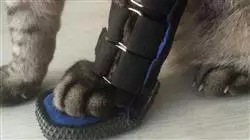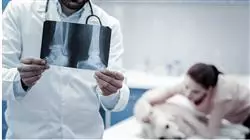University certificate
The world's largest faculty of veterinary medicine”
Description
Veterinarians must continue their training to adapt to new developments in this field"

This specialization is the best option you can find to specialize in Common Fractures in Cats and Dogs"
The teaching team of this postgraduate diploma in Common Fractures in Cats and Dogs has made a careful selection of the different state-of-the-art techniques for experienced professionals working in the veterinary field. Specifically, the training focuses on pelvic and pelvic and thoracic limb fractures.
Pelvic fractures account for 20-30% of all fractures in small animals, which is a high incidence in the clinical situation of trauma and orthopedic services in veterinary hospitals and clinics.
These fractures are characterized by commonly affecting more than one of the bones of the pelvis or associated adjoining structures, a situation that requires the clinician to have a detailed knowledge of the anatomy and biomechanics of the pelvis, in order to achieve an optimal therapeutic outcome in each patient.
It is of vital importance to know the pathophysiological alterations that can be found in a patient with a pelvic fracture, since most of these presentations are associated with high-energy trauma, such as traffic accidents or falls from high heights.
In turn, 20% of the fractures that occur in the daily clinical practice of dogs and cats occur in the femur. This bone is surrounded by a large amount of muscle mass, therefore, it is a bone that is difficult to fixate, but has a good response to bone repair after a fracture, as long as the fixation method fulfills its objective.
In the femur, given the large number of fractures of different types that can occur, we will talk about very precise osteosynthesis, precise rigid destabilizations, in which the basic principles of osteosynthesis and each of the systems must be followed consistently to achieve success with different fixation systems.
Finally, distal humerus fractures are the most complicated fractures, since there is a large area of articular surface in a minimal portion of bone, so a fracture of the distal portion of the humerus must be treated accurately, effectively and stably. This postgraduate diploma analyzes the importance of the choice of implant for the correct treatment of this type of fracture, as well as for radius and ulna fractures, which are also complicated in terms of their repair and clinical union due to the fact that they are bones with little muscular mass, therefore, the blood perfusion of the tissue is minimal.
The teachers in this specialization are university professors with between 10 and 50 years of classroom and hospital experience. They are professors from schools on different continents, with different ways of doing surgery and with world-renowned surgical techniques. This makes this program a unique postgraduate diploma, different from any other that may be offered at this moment in the rest of the universities.
Do not miss the opportunity to take with us this postgraduate diploma in Common Fractures in Cats and Dogs. It's the perfect opportunity to advance your career"
This postgraduate diploma in Common Fractures in Cats and Dogs features the most complete and up to date educational program on the market. The most important features include:
- The development of case studies presented by experts in Common Fractures in Cats and Dogs
- The graphic, schematic, and eminently practical contents with which they are created, provide scientific and practical information on the disciplines that are essential for professional practice
- Developments on quality control in Common Fractures in Cats and Dogs
- Practical exercises where the self-assessment process can be carried out to improve learning
- Special emphasis on innovative methodologies in the management of Common Fractures in Cats and Dogs
- Theoretical lessons, questions to the expert, debate forums on controversial topics, and individual reflection work
- Content that is accessible from any fixed or portable device with an Internet connection
This postgraduate diploma is the best investment you can make in selecting a refresher program to update your knowledge in Common Fractures in Cats and Dogs"
Its teaching staff includes professionals from the veterinary field, who bring the experience of their work to this training, as well as recognised specialists from leading societies and prestigious universities.
The multimedia content, developed with the latest educational technology, will provide the professional with situated and contextual learning, i.e., a simulated environment that will provide immersive training programmed to train in real situations.
This program is designed around Problem Based Learning, whereby the professional must try to solve the different professional practice situations that arise during the program. For this purpose, the professional will be assisted by an innovative interactive video system developed by renowned and experienced experts in Common Fractures in Cats and Dogs.
This training comes with the best didactic material, providing you with a contextual approach that will facilitate your learning"

This 100% online postgraduate diploma will allow you to combine your studies with your professional work while increasing your knowledge in this field"
Objectives
The program in Common Fractures in Cats and Dogs is oriented to facilitate the performance of the veterinary professional with the latest advances and newest treatments in the sector.

This is the best option to learn about the latest advances in common fractures in cats and dogs"
General Objectives
- Detail the anatomy of the pelvic region, as well as closely related regions
- Identify "candidate patients" for conservative or surgical treatment following a pelvic fracture
- Specialize in the various systems of fixation of pelvic fractures
- Establish the main complications associated with pelvic fractures
- Evaluate the immediate post-surgical needs in patients with pelvic fractures, as well as their medium and long term evolution
- Develop a theoretical and practical knowledge of osteosynthesis in specific fractures of the femur, tibia and patella
- Promote specialized criteria for decision making in specific fractures with specific repairs in each of the clinical situations in femur, patella and tibia
- Develop specialized knowledge of osteosynthesis in complicated fractures of the scapula, humerus, radius and ulna
- Develop specialized decision making criteria for "specific" fractures
- with "specific" repairs in each of the fractures that exist in the scapula, the humerus, radius
Specific Objectives
- Analyze and identify the clinical features associated with a pelvic fracture
- Recognize and evaluate the various factors in patients with pelvic fractures that allow us to make an accurate prognosis
- Perform surgical approaches in the various anatomical regions where therapeutic procedures are performed
- Apply the various conservative therapies in patients with pelvic fractures, both in the initial stages and in the subsequent weeks of recovery
- Specialize the veterinary professional in the performance of standard and proper maneuvers in the reduction of pelvic fractures
- Select the appropriate surgical implant for each type of pelvic pathology, identifying the advantages and disadvantages of each case
- Specialize the veterinary professional in the surgical techniques characteristic of specific pelvic pathologies
- Perform a correct analgesic management of patients in their immediate and medium and long term postoperative period
- Develop the main methods of rehabilitation and return of functionality of patients with pelvic fractures
- Establish the classification of proximal femoral fractures and develop expertise on the most recommended fixation methods for successful repair of fractures
- Compile the different systems and combinations of osteosynthesis systems in the repair of femoral mid-weight fractures
- Analyze the different methods of fixation and specialize in those that offer the highest success rate of fixation of knee fractures
- Determine the different fractures involving the tibia and specialise in the most recommended fixation methods for the solution of their fractures
- Examine the most common fractures encountered in daily practice, their diagnosis and surgical resolution
- Analyze fractures of the scapula and how to fix each of them
- Examine the classification of distal humerus fractures
- Determine the most recommended methods of fixation for successful fracture repairs
- Develop specialized training in the different combinations of osteosynthesis systems for the repair of fractures of the middle third of the humerus
- Study the different methods of fixation and refine knowledge in those methods that have the highest success rate among the different methods of elbow fracture fixation
- Specify the different fractures involving the radius and ulna
- Analyze the different methods of fixation most recommended for the solution of radius and ulna fractures
- Detail the most common fractures of the region, diagnosis and surgical resolution
- Examine fractures and dislocations of the carpus and phalanges and the most effective fixation of these fractures and dislocations
- Determine forelimb growth abnormalities, origin and treatment by angular corrections through osteotomies and associated methods of treatment
- Determine the most common fractures of the mandible and maxilla, as well as the different ways to solve them

A unique, key and decisive training experience to boost your professional development"
Postgraduate Diploma in Common Fractures in Dogs and Cats
Bone fractures are common injuries in dogs and cats, and it is crucial to understand them in order to provide the best veterinary care. In this regard, it is important for professionals to know how to address common fractures that affect pets and how they can be effectively diagnosed and treated. Given this scenario, TECH Global University developed the Postgraduate Diploma in Common Fractures in Dogs and Cats as an excellent opportunity for qualification in the area, without having to leave home. This program, completely virtual in nature, will add to your curriculum the most updated competencies in the market so that you can perform effectively in the field of common fractures in dogs and cats. Throughout the curriculum, you will explore the most common causes of such injuries and the best practices for diagnosis, treatment and rehabilitation.
Master common fractures in dogs and cats
This program covers several modules, through which you will learn the most relevant and up-to-date approaches in this field. First, you will examine the causes of fractures in dogs and cats, from trauma due to accidents to bone diseases. Next, you will delve into the most advanced diagnostic techniques to evaluate and confirm the presence of a fracture. You will also delve into the different treatment options available for common fractures in dogs and cats. Finally, you will study the rehabilitation process and post-fracture care. You will learn all this through innovative methodologies that incorporate time flexibility, interactive immersion, dynamic flow of topics and continuous motivation by experts. For all this and more, we are your best educational option. Decide and enroll now!







